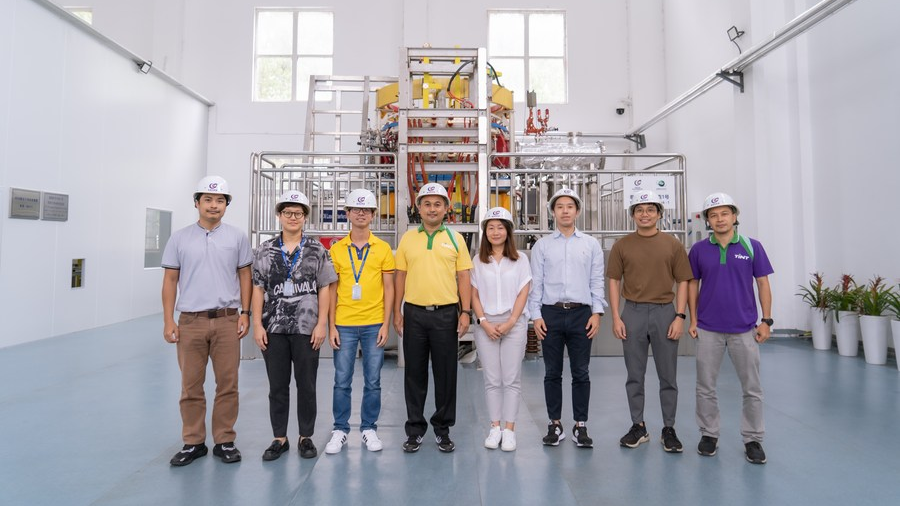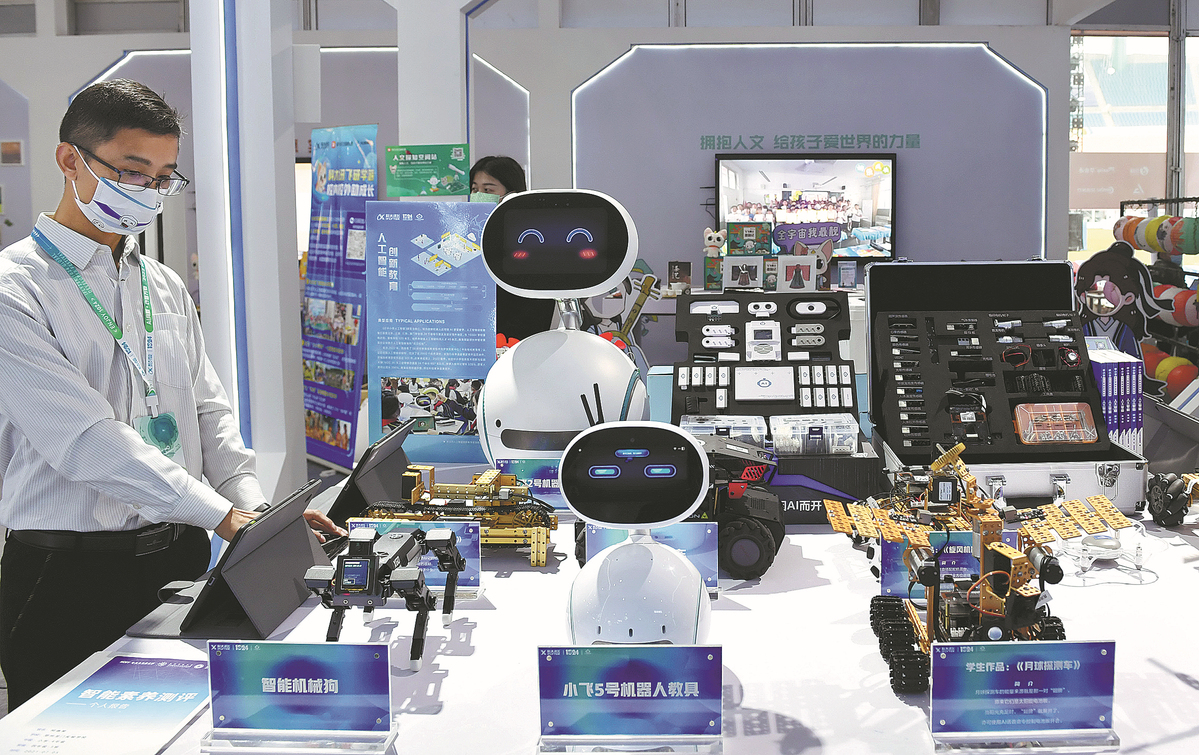You are using an out of date browser. It may not display this or other websites correctly.
You should upgrade or use an alternative browser.
You should upgrade or use an alternative browser.
News on China's scientific and technological development.
- Thread starter Quickie
- Start date
Built in 3 Years :O
China helps Thailand build 'artificial sun' tokamak for research

Scientists and engineers from Thailand pose for a photo in front of the Thailand Tokamak 1 (TT-1) machine in Hefei City, east China's Anhui Province, August 24, 2022. /Xinhua
A giant tokamak, an experimental machine in which an ultra-high temperature plasma can be created to simulate the conditions for fusion reaction, has been dismantled and well-packaged in Hefei City, the capital of east China's Anhui Province. It is scheduled to be shipped to Thailand in mid-December.
The facility, renamed Thailand Tokamak 1 (TT-1), was developed by the Institute of Plasma Physics of the Chinese Academy of Sciences (ASIPP).
According to a cooperation agreement signed in 2017, the ASIPP would donate the tokamak to the Thailand Institute of Nuclear Technology (TINT) and help the country install and operate this facility and cultivate talent in the domain of fusion energy research and development.
"The whole facility is composed of 462 major parts, weighing over 84 tonnes. They will be shipped to Thailand in six containers," said Huang Yiyun, a key member of this project from ASIPP.
The facility is expected to arrive in Thailand in early January 2023. Three batches of Chinese staff, about 60 people in total, will be sent to Thailand to help assemble, adjust and test the machine before its official launch.
The ultimate goal of this kind of research is to create nuclear fusion like the sun, using deuterium abound in the sea to provide a steady stream of clean energy. It is estimated that the deuterium in one liter of seawater can produce, through fusion reaction, the amount of energy equivalent to 300 liters of gasoline.
To gain adequate theoretical knowledge and harness the operation of the tokamak, a group of nine scientists and engineers from Thailand came to Hefei in late June for an intensive training program, which lasted for over three months.
"We're all excited to see the coming of the TT-1 device. A new building has been specially designed to accommodate the facility in Thailand," said Dr. Nopporn Poolyarat, head of the Fusion and Plasma Division of TINT, in an email to Xinhua.
The Center of Excellence in Molecular Plant Sciences of the Chinese Academy of Sciences and a team from Shanghai Normal University have successfully cloned a protein-rich gene from wild maize and through experiments for the first time. hybridization, the protein content of modern maize has been effectively increased
AI industry in China gaining global influence
By ZHU LIXIN in Hefei | China Daily | Updated: 2022-11-19 08:04

China had contributed 70.9 percent of the world's patents in artificial intelligence by 2021 with 5.3 percent of the world's professionals in the field, showing China's growing global influence in the AI industry, experts said on Friday.
"The data illustrated that China's AI industry has been gaining more importance in the world," said Zhang Li, president of China Center for Information Industry Development, adding that China's AI patents had surged to 80,785 by end of 2021 from 7,968 as of 2012.
In the past decade, China had launched many favorable policies to promote AI research and development, talent training and applications, thus fueling such rapid growth. It has also been exploring new paths for AI development and mechanisms to let AI technology better serve the economy, said Zhang.
He made the remarks as he released the China Artificial Intelligence Industry Development Index Report during the opening ceremony of the 2022 iFlyTek 1024 Global Developer Festival, a three-day event that kicked off on Friday in Hefei, Anhui province.
The report classified the 31 provincial-level regions on the Chinese mainland into four groups based on evaluations of their development climate, innovation competence, basic supporting facilities, capital input and industrialization strengths.
Beijing, Shanghai and Guangdong province were in the lead group, while Zhejiang, Jiangsu, Anhui, Sichuan and Hunan provinces formed the group of challengers. Other regions fell into followers and niche regions.
For example, Anhui has been moving up in the AI industry rapidly in recent years, with more than 90 of the province's technology breakthroughs, applications and talent from the provincial capital Hefei, said Zhang.
"Digitization could provide powerful strength for recovery of the world economy, while we believe AI is a core engine for the digital economy," said Liu Qingfeng, founder and president of iFlyTek, a Hefei-based AI developer ranking fifth among the country's top 100 AI firms, according to the report.
As AI development is inseparable from advancement of computing competence, research in quantum computing could provide powerful support in the future, according to Pan Jianwei, member of the Chinese Academy of Sciences.
Also executive vice-president of the Hefei-based University of Science and Technology of China, Pan had led the university's researchers in creating the world's first light-based prototype quantum computer, called Jiuzhang, in 2020.
Using a new method of manipulating 76 photons, it can perform an extremely difficult calculation known as Gaussian boson sampling in 200 seconds. The same task would take the world's fastest classical supercomputer, Fugaku, around 600 million years.
Last year, his team launched the Jiuzhang-2, the second edition of the computer, which could manipulate 113 photons simultaneously.
In his speech at Friday's ceremony, Pan said the team had recently made major breakthroughs for developing Jiuzhang-3, whose computing speed was expected to be 1,000 trillion times faster than the world's most powerful supercomputer for specific tasks.
not only in Ai, but also civil aviation , civil engine components , semiconductor and biomedical too. basically Shanghai is China's backbone in high end industry research and development.
China helps Thailand build 'artificial sun' tokamak for research

Scientists and engineers from Thailand pose for a photo in front of the Thailand Tokamak 1 (TT-1) machine in Hefei City, east China's Anhui Province, August 24, 2022. /Xinhua
A giant tokamak, an experimental machine in which an ultra-high temperature plasma can be created to simulate the conditions for fusion reaction, has been dismantled and well-packaged in Hefei City, the capital of east China's Anhui Province. It is scheduled to be shipped to Thailand in mid-December.
The facility, renamed Thailand Tokamak 1 (TT-1), was developed by the Institute of Plasma Physics of the Chinese Academy of Sciences (ASIPP).
According to a cooperation agreement signed in 2017, the ASIPP would donate the tokamak to the Thailand Institute of Nuclear Technology (TINT) and help the country install and operate this facility and cultivate talent in the domain of fusion energy research and development.
"The whole facility is composed of 462 major parts, weighing over 84 tonnes. They will be shipped to Thailand in six containers," said Huang Yiyun, a key member of this project from ASIPP.
The facility is expected to arrive in Thailand in early January 2023. Three batches of Chinese staff, about 60 people in total, will be sent to Thailand to help assemble, adjust and test the machine before its official launch.
The ultimate goal of this kind of research is to create nuclear fusion like the sun, using deuterium abound in the sea to provide a steady stream of clean energy. It is estimated that the deuterium in one liter of seawater can produce, through fusion reaction, the amount of energy equivalent to 300 liters of gasoline.
To gain adequate theoretical knowledge and harness the operation of the tokamak, a group of nine scientists and engineers from Thailand came to Hefei in late June for an intensive training program, which lasted for over three months.
"We're all excited to see the coming of the TT-1 device. A new building has been specially designed to accommodate the facility in Thailand," said Dr. Nopporn Poolyarat, head of the Fusion and Plasma Division of TINT, in an email to Xinhua.
Are they selling this machine? Does that mean they already have better machines?
Interesting,so you can get tougher silk by feeding silkworm carbon nanotubes
In 2016, the team of Associate Professor Zhang Yingying from the Department of Chemistry of Tsinghua University published an article titled "Feeding silkworms with single-walled carbon nanotubes or graphene to obtain enhanced The article "Feeding Single-Walled Carbon Nanotubes or Graphene to Silkworms for Reinforced Silk Fibers" has attracted many people's attention.
The research team began to feed the silkworms sprayed with graphene/carbon nanotube aqueous solution when they were 3 years old, and continued until the silkworms spun silk and cocooned. It was found that the strength and toughness of the silk obtained in this way were significantly improved compared with the blank control sample, and the conductivity of the carbonized fibers formed by the silk containing graphene/carbon nanotubes was significantly improved after high-temperature carbonization treatment. They also found that feeding a small amount of graphene/carbon nanotubes had no significant effect on silkworm growth and cocoon morphology, and carbon nanomaterials were present in silkworm silk and silkworm excrement.
